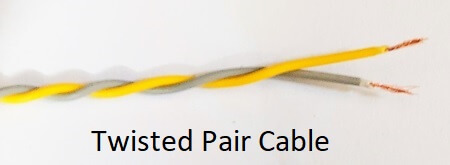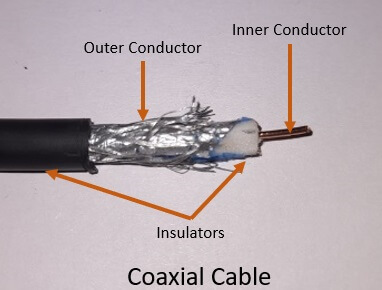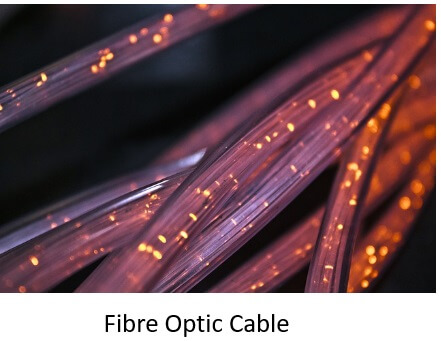Guided transmission media is the physical medium that is used to transfer information bits from one computer to the other. The physical medium directs the path that information bits have to follow to reach the desired receiver.
The other transmission medium is the unguided transmission media which does not incorporate any physical medium for the transmission of the information. We will discuss unguided transmission in some other content. In this section, we will discuss the different kinds of guided transmission media.
Kinds of Guided Transmission Media
1. Magnetic Media
Magnetic media is a common and oldest method to transport information from one computer to another computer which is still being used. The information that is to be transferred is first written on any removable ‘magnetic disk’. This magnetic disk is then removed physically and attached to the destination computer on which data has to be transferred. The destination computer or the receiver computer then read the data from the magnetic disk.
This is the fastest yet safest media of transmission. This is even the cost-friendly approach to transfer the data between two computers. The magnetic media have its own speed and cost benefits but there can occur delay in transmission and if you observe the time of transmission is measured in minutes and hours which we nowadays count in seconds.
2. Twisted Pair Cable
Though we have a trusted magnetic media still some applications need an online connection. Twisted pair media provides an online connection. Let us discuss the physical structure of the twisted pair cable.

We all are familiar with the structure of the twisted pair cable. It involves two copper wires that are insulated and are twisted around each other in a helical pattern just like the DNA strands. Though it consists of a pair of wire it acts as a single communication line.
Now, what’s the reason behind twisting the wires. One of the twisted cables is for carrying the ‘signal’ and others complete the ‘ground circuit’. Along with signal, there is interference such as ‘noise’ and ‘crosstalk’ that can affect the signal which may result in generating the ‘unwanted signal’.
If the two wires are kept parallel the unwanted signal created due to noise and cross talk affect them differently as they both are at a different distance corresponding to noise and crosstalk. This results in the difference at the receiver side also.
But when the pair of the cable is twisted then it cancels the difference and let both the wire get equally affected by the interference.
The twisted-pair cable transmits the analog as well as a digital signal. One of the constraints in using the twisted pair cable is the distance for which it can be used efficiently. If you are using twisted pair for transmitting analog transmission then you require amplifier at every 5 to 6 km for maintaining the strength of the signal. If you are using for digital transmission then you require repeater at every 2 to 3 km.
The twisted-pair cable has two variants i.e. unshielded and shielded twisted pair cable. The unshielded twisted pair is very common and useful in telephone communication.
The shielded twisted pair has a metal shield or braid over the insulated copper wire it improves the quality and service of the wire. However, it also increases the cost of the wire and if we talk of convenience unshielded twisted pair is more convenient to work with.
Based on the quality of cable you can categorize the unshielded twisted cable from category 1 as the lowest category to category 7 as the highest category.
Advantages
- Twisted pair cable transmits signal ranging from 0 to 3.5 kHz.
- The twisted-pair cables are easy to install and less expensive.
- Can be used for both analog and digital signals.
Disadvantages
- Signal weakens after every 2 km.
- Require repeaters and amplifier at a very short distance.
- Twisted pair cable can be tapped easily because the antenna can be realized easily in a copper wire.
3. Co-axial Cable
The coaxial cable also incorporates two cables for transmitting information from one system to another like the twisted pair cable. But the difference is in their structure and performance. The coaxial cable is able to transmit signal with a higher frequency range.
Let us now discuss the physical structure of the coaxial cable. The coaxial cable has two conductors where there is a one core central insulated conductor that is encapsulated with one hollow cylindrical conductor as you can see in the figure below.

The first core conductor is insulated which is then covered by the second conductor metal foil or braid or the combination of both. This second conductor is then encased with the insulating sheath and finally, the entire cable is insulated.
The outer second conductor completes the ground circuit and even prevents noise or other interference. When it comes to the distance the coaxial cable can be used for a longer distance compared to twisted pair cable.
The coaxial cable is used for television cable, telephone connection, the connection between computer, LAN.
Advantages
- Provides better bandwidth compared to twisted pair cable.
- Used as conventional television cable.
- Immune to noise as it has a better shield as compared to twisted pair cable.
Disadvantages
- Expensive and hard to install as compared to the twisted pair cable.
4. Power Lines
We don’t require the transmission media only for television and telephone connection. So, for what else we require the transmission media, its for electrical supply. The power line supplies the electrical power to the houses.
Earlier the power line was used for transmitting information from one system to the other. The concept of using power line for high rate communication is in trend again. The power lines are being used for the LAN connection and for internet broadband connection.
5. Fibre Optic Cable
Fibre optic cable is the fastest media for transmitting information from one system to another. It transmits the information with the speed of light. Let us discuss the physical structure of the fibre optic cable.
Fibre optic cable is a thin fibre made of glass or plastic. It has a diameter thin as human hair. The optical fibre cable has three encasing the core, cladding and jacket. The innermost i.e. core which has one or more thin fibre strands. Now, each of the strands is encased in its own cladding. The cladding is nothing but a glass or plastic coating over the strand. And all these cladded fibres are then encased in a jacket.

Now for transmitting information via fibre optic cable three components are required that are a light source, a medium for transmission, and a detector. At the sender side, the electrical signals are converted to pulses of light and are transmitted over the optic fibre the light reflects and travel from the core of the fibre.
At the receiver side, there is a detector which detects the pulse of light and converts it back to an electric signal. Every pulse of light is considered as 1 bit and if the pulse of light is absent then it is considered as 0 bit.
The fibre optic provides two modes of propagation:
- Multi-mode Propagation
Multimode propagation has multiple beams of light that arrive from the source of light and travel through the core of fibre optic cable with different paths. This propagation uses two kinds of fibres, step-index and graded-index.
The step-index fibre is one where the core density remains constant through the entire fibre optic cable.
Graded index fibre is one with a varying density which means the core density varies through the entire optic fibre. At the centre of the core, the density is at its highest and gradually decreases reaching the edge. - Single-mode Propagation
Instead of multiple beams of light, it has a single focus beam of light which has a very low range of angles and all angles are very close to the horizontal. It uses a step-index fibre.
Advantages
- Fibre optic cable provides high-speed transmission.
- It does not get affected by any electromagnetic interference.
- Immune to attenuation, does not require to regenerate signal even after 50 km.
- Due to the material uses it is less affected by corrosive material.
- Fibre optic cable is light in weight and cannot be tapped easily.
Disadvantages
- They are expensive when it comes to installation and maintenance.
- The fibre optic cable unidirectional and provide one-way communication. If you want bidirectional communication you have to install two cables.
So, this is all about the guided transmission media i.e. a physical medium for transmitting information where the path for transmission is decided by the medium we use. We have covered all kinds of guided transmission media.

Leave a Reply